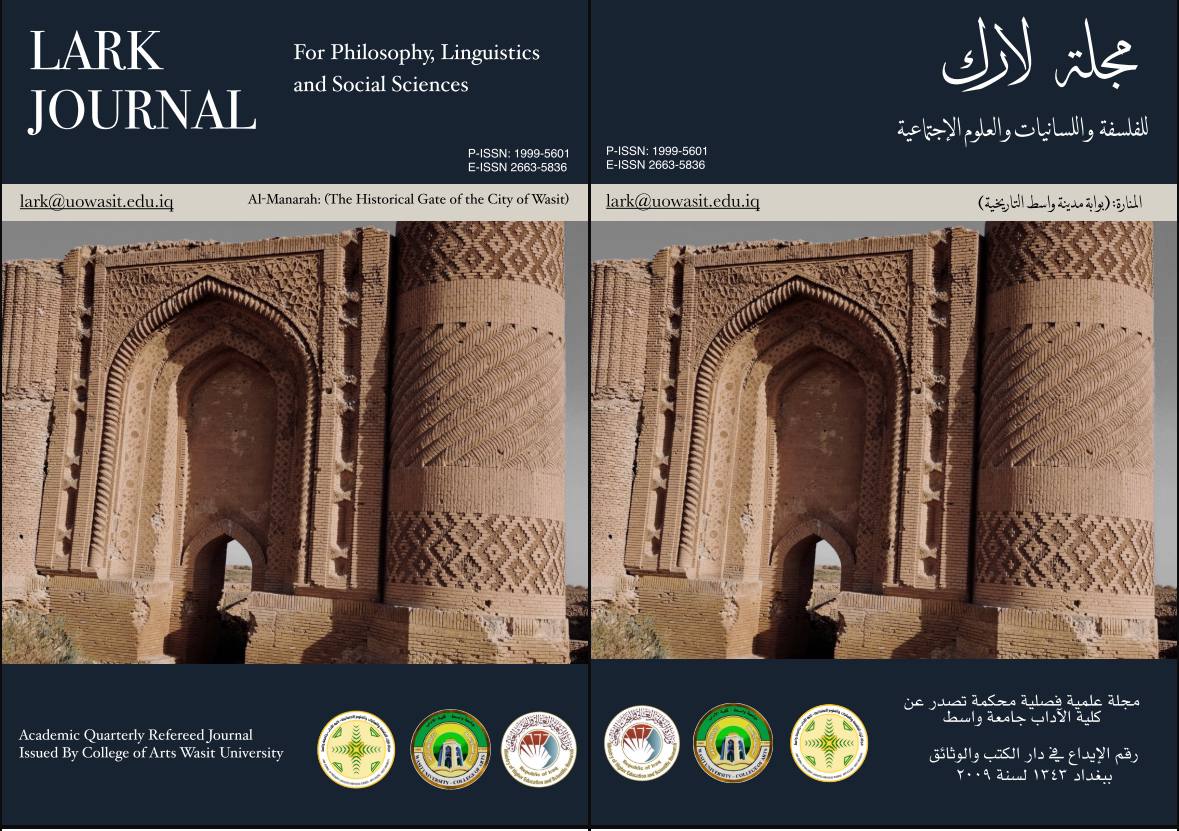Number and the theory of classes in ancient Arabic criticism
DOI:
https://doi.org/10.31185/lark.4619Keywords:
criticism, number, class, poetryAbstract
This research seeks to uncover the role played by numbers in ancient Arabic criticism, particularly in the theory of classes. Ancient Arab critics were keen to use numbers in their critical discourse as a tool for evaluating, organizing, and classifying poets, dividing them into classes according to precise critical criteria. The most prominent manifestation of the relationship between numbers and class theory is found in Ibn Salam al-Jumahi (d. 231 AH) in his book (Tabaqat Fuhuul al-Shu'ara'). He was keen to divide and classify poets according to systematic classes, relying on critical criteria that combined artistic quality, time, and the number of poems, among other critical criteria. Throughout all of this, he used numbers as a means of evaluation and organization. This helped him to imbue his judgments with an objective character, making him one of the first Arab critics to employ numbers not only as a numerical tool, but also as a critical construct for distinguishing and differentiating between poets.
References
المصادر والمراجع
1. ابن قتيبة، أبو محمد عبد الله بن مسلم، (د. ت)، الشعر والشعراء، تحقيق وشرح: أحمد محمد شاكر، دار المعارف، القاهرة - مصر، ج1، (د. ط).
2. الجاحظ، أبو عثمان عمرو بن بحر، (1998م)، البيان والتبين، ، تحقيق وشرح: عبد السلام محمد هارون، مكتبة الخانجي للطباعة والنشر والتوزيع، القاهر- مصر، ط7.
3. الجمحي سلام، طبقات فحول الشعراء، ابن قرأه وشرحه: محمود محمد شكر، دار المدني، جدة - السعودية، (د. ط)، (د. ت).
4. الشكعه، د. مصطفى، (1991م)، مناهج التأليف عند العلماء قسم الأدب، دار العلم للملايين، بيروت - لبنان، ط6.
5. الصفار، د. ابتسام مرهون، حلاوي، د. ناصر، (1999م)، محاضرات في تاريخ النقد عند العرب، دار الكتب للطباعة والنشر، بغداد، ط2.
6. الكواز، محمد كريم، (2006م)، البلاغة والنقد المصطلح والنشأة والتجديد، دار الانتشار العربي، بيروت - لبنان، ط1.
7. المجالي، د. جهاد، (1992م)، طبقات الشعراء في النقد الأدبي عند العرب حتى نهاية القرن الثالث الهجري، دار الجيل، بيروت - لبنان، ط1.
8. إبراهيم، الأستاذ طه أحمد ، (1988م)، تاريخ النقد الأدبي عند العرب من العصر الجاهلي إلى القرن الرابع الهجري، دار القلم، بيروت - لبنان، ط1.
9. جدوانة، د. حسين، (2011م)، دراسات في النقد الأدبي القديم، مؤسسة حمادة للدراسات الجامعية والنشر والتوزيع، عمان - الأردن، ط1.
10. طبانة، د. بدوي (1969م)، دراسات في نقد الأدب العربي من الجاهلية إلى نهاية القرن الثالث، مكتبة الأنجلو المصرية، القاهرة - مصر، ط5.
11. سلطان، د. منير، (1986م)، ابن سلام وطبقات الشعراء، منشأة معارف، الاسكندرية - مصر، ط2.
12. سلوم، د. داود، (1981م)، مقالات في تاريخ النقد العربي، دار الطليعة للطباعة والنشر، بيروت - لبنان، (د. ط).
13. عباس، د. إحسان، (1983م)، تاريخ النقد الأدبي عند العرب نقد الشعر من القرن الثاني حتى القرن الثامن الهجري، دار الثقافة، بيروت - لبنان، ط4.
14. مكي، د. الطاهر أحمد، (1999م) دراسة في مصادر الأدب، دار الفكر العربي، القاهرة - مصر، ط8.
Sources and Referennces
1. Ibn Qutaybah, Abu Muhammad Abdullah ibn Muslim, (n.d.), Poetry and Poets, edited and explained by Ahmad Muhammad Shakir, Dar al-Ma'arif, Cairo, Egypt, Vol. 1, (n.d(.
2. al-Jahiz, Abu Uthman Amr ibn Bahr, (1998), Al-Bayan wa al-Tabyeen, edited and explained by Abd al-Salam Muhammad Harun, al-Khanji Library for Printing, Publishing, and Distribution, Cairo, Egypt, 7th ed.
3. al-Jamhi Salam, Classes of the Great Poets, Ibn Qara'ah and explained by Mahmoud Muhammad Shukr, Dar al-Madani, Jeddah, Saudi Arabia, (n.d.), (n.d.(
4. al-Shaka'ah, Dr. Mustafa, (1991), Methods of Authorship Among Scholars, Literature Department, Dar al-Ilm lil-Malayin, Beirut, Lebanon, 6th ed.
5. al-Saffar, Dr. Ibtisam Marhoun; Halawi, Dr. Nasser, (1999), Lectures on the History of Arab Criticism, Dar al-Kutub for Printing and Publishing, Baghdad, 2nd ed.
6. Al-Kawaz, Muhammad Karim (2006), Rhetoric and Criticism: Terminology, Origins, and Renewal, Dar Al-Intishar Al-Arabi, Beirut, Lebanon, 1st ed.
7. Al-Majali, Dr. Jihad (1992), Classes of Poets in Arab Literary Criticism until the End of the Third Century AH, Dar Al-Jeel, Beirut, Lebanon, 1st ed.
8. Ibrahim, Professor Taha Ahmad (1988), History of Arab Literary Criticism from the Pre-Islamic Era to the Fourth Century AH, Dar Al-Qalam, Beirut, Lebanon, 1st ed.
9. Jadwana, Dr. Hussein (2011), Studies in Ancient Literary Criticism, Hamada Foundation for University Studies, Publishing, and Distribution, Amman, Jordan, 1st ed.
10. Tabana, Dr. Badawi (1969), Studies in Arabic Literary Criticism from the Pre-Islamic Era to the End of the Third Century AH, Anglo-Egyptian Library, Cairo, Egypt, 5th ed.
11. Sultan, Dr. Munir, (1986), Ibn Salam and the Classes of Poets, Mansha'at Maaref, Alexandria, Egypt, 2nd ed.
12. Salloum, Dr. Daoud, (1981), Articles on the History of Arab Criticism, Dar Al-Tali'a for Printing and Publishing, Beirut, Lebanon, (n.d.(
13. Abbas, Dr. Ihsan, (1983), The History of Literary Criticism Among the Arabs: Criticism of Poetry from the Second to the Eighth Century AH, Dar Al-Thaqafa, Beirut, Lebanon, 4th ed.
14. Makki, Dr. Al-Taher Ahmad, (1999), A Study of the Sources of Literature, Dar Al-Fikr Al-Arabi, Cairo, Egypt, 8th ed.
Downloads
Published
Issue
Section
License
Copyright (c) 2025 الباحث: حسام طه زيدان العتبي، أ. د. سعد داحس ناصر الحسني

This work is licensed under a Creative Commons Attribution 4.0 International License.





